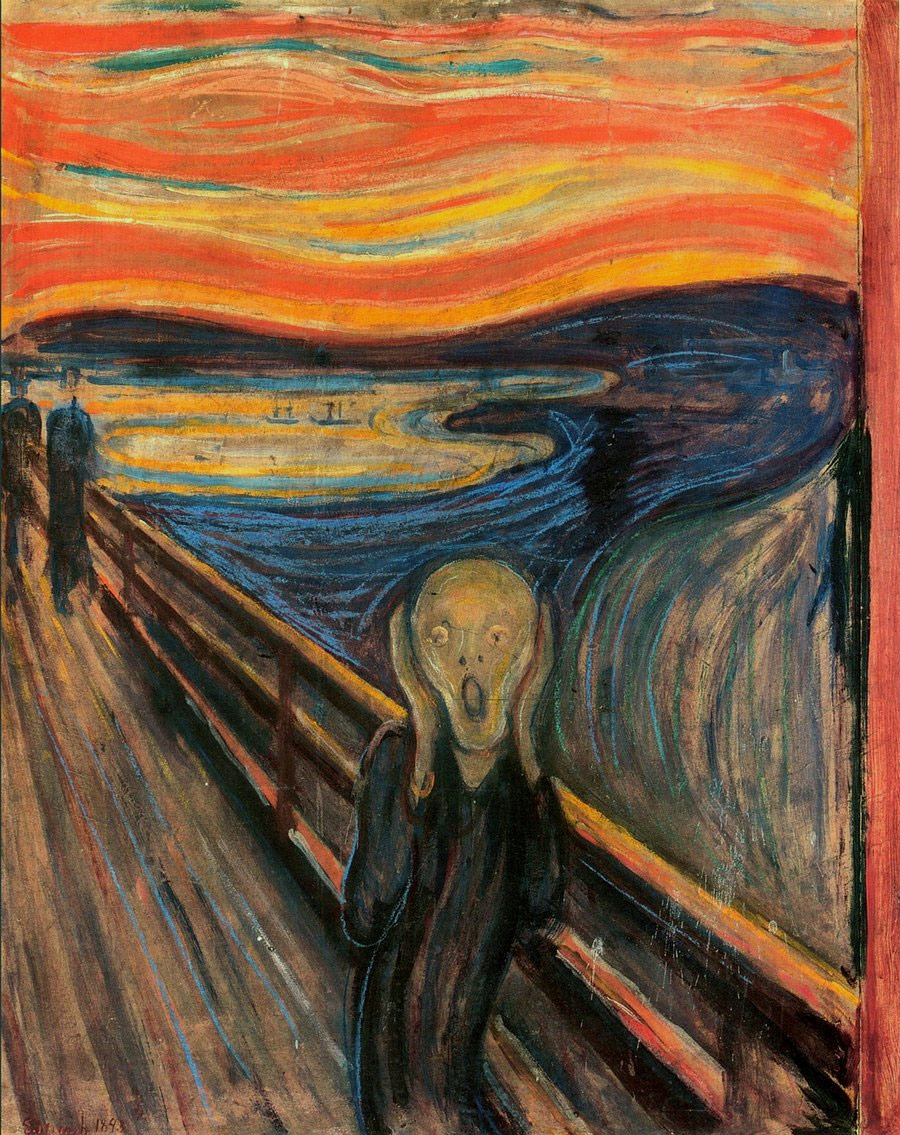| The Scream | |
|---|---|
 |
|
| Artist | Edvard Munch |
| Year | 1893 |
| Medium | Oil, tempera, and pastel on cardboard |
| Location | National Gallery, Oslo, Norway |
| Dimensions | 36 in × 28.9 in |
| 91 cm × 73.5 cm | |
| Famous Paintings by Edvard Munch | |
| The Scream | |
| The Sick Child | |
| Death in the Sickroom | |
| The Dance of Life | |
| Madonna | |
| Vampire | |
| Anxiety | |
| Ashes | |
| Puberty | |
| Complete Works |
The Scream painting by Edvard Munch is one of the most well-known pieces of artwork in history, appealing to a wide audience even today. There are actually four different original versions of The Scream that Edvard Much created using different art mediums including oil paints, tempera, and pastels. The Scream is part of a larger art collection series that Edvard Munch called The Frieze of Life.
In The Scream’s timeless image is a genderless person with a pale face, standing beside a railing with an expansive view of a chaotic environment. What is so gripping about the image is that the person is screaming, their mouth hung wide open with their hands on the sides of their face, and you can see that scream reflected and continuing on into the distance of the intensely bloody red, orange, deep blue, and black colored background. Two people stand with their backs turned to the screaming figure, with their black silhouettes on the very edge of the scene. Far in the distance there is a hint of a small city, almost completely lost in the swirling sky.
Two of The Scream artworks are paintings, and the other two were done in pastels. The National Gallery in Oslo, Norway owns one of The Scream paintings, the Munch Museum holds the other “Scream” painting and one pastel, and another pastel is privately owned by Petter Olsen. Mr. Olsen is auctioning off his original “Scream” pastel artwork by Edvard Munch through Sotheby’s in New York on May 2, 2012. It’s estimated that just this one pastel artwork version of The Scream will sell for around $80 million dollars, making it one of the most valuable art pieces ever auctioned in history.
Inspiration for The Scream
Norwegian by birth, Edvard Munch studied at the Oslo Academy with famous Norwegian artist Christian Krohg. He created the first version of The Scream in 1893 when he was about 30 years old, and made the fourth and final version of The Scream in 1910. He has described himself in a book written in 1900 as nearly going insane, like his sister Laura who was committed to a mental institution during this time period as well. Personally he discussed being pushed to his limits, and going through a very dark moment in his life.
The scene of The Scream was based on a real, actual place located on the hill of Ekeberg, Norway, on a path with a safety railing. The faint city and landscape represent the view of Oslo and the Oslo Fjord. At the bottom of the Ekeberg hill was the madhouse where Edvard Munch’s sister was kept, and nearby was also a slaughterhouse. Some accounts describe that in those times you could actually hear the cries of animals being killed, as well as the cries of the mentally disturbed patients in the distance. In this setting, Edvard Munch was likely inspired by screams that he actually heard in this area, combined with his personal inner turmoil. Edvard Munch wrote in his diary that his inspiration for The Scream came from a memory of when he was walking at sunset with two friends, when he began to feel deeply tired. He stopped to rest, leaning against the railing. He felt anxious and experienced a scream that seemed to pass through all of nature. The rest is left up to an endless range of interpretations, all expressed from this one, provocative image.
The Unique Style of The Scream and its Influences on the Expressionist Movement
Many sources agree that the way that Edvard Munch portrayed pure, raw emotion in this artwork was a radical shift from the art tradition of his own time, and he is therefore credited with beginning the expressionist movement that spread through Germany and on to other parts of the world. Most of Edvard Munch’s work relates to themes of sickness, isolation, fear and death.
The Characteristic Techniques Used to Create The Scream
One early version of this scene was created by Edvard Munch on a cardboard surface, using tempera, oil paints, and pastels together. Another version is only done with tempera on cardboard, and these early versions have almost violent, explosive strokes across the surface that deliver a high impact on the viewer. One of the later versions of The Scream was a lino print done in black and white only. Edvard Munch liked to add shadows and auras of color around his main subjects to add to the intensity of their emotions.